Passitexams
On this page, you find all documents, package deals, and flashcards offered by seller PassitExams.
- 307
- 0
- 10
Community
- Followers
- Following
317 items
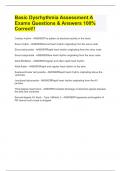
Basic Dysrhythmia Assessment A Exams Questions & Answers 100% Correct!!
Cardiac rhythm - ANSWERThe pattern of electrical activity in the heart Sinus rhythm - ANSWERNormal heart rhythm originating from the sinus node Sinus tachycardia - ANSWERRapid heart rhythm originating from the sinus node Sinus bradycardia - ANSWERSlow heart rhythm originating from the sinus node Atrial fibrillation - ANSWERIrregular and often rapid heart rhythm Atrial flutter - ANSWERRapid and regular
- Exam (elaborations)
- • 1 pages •
Cardiac rhythm - ANSWERThe pattern of electrical activity in the heart Sinus rhythm - ANSWERNormal heart rhythm originating from the sinus node Sinus tachycardia - ANSWERRapid heart rhythm originating from the sinus node Sinus bradycardia - ANSWERSlow heart rhythm originating from the sinus node Atrial fibrillation - ANSWERIrregular and often rapid heart rhythm Atrial flutter - ANSWERRapid and regular
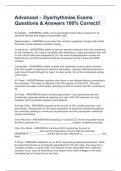
Advanced – Dysrhythmias Exams Questions & Answers 100% Correct!!
Excitability - ANSWERthe ability of non-pacemaker heart cells to respond to an electrical impulse that begins in pacemaker cells. Depolarization - ANSWERoccurs when the normally negatively charged cells within the heart muscle develop a positive charge. Conductivity - ANSWERthe ability to send an electrical stimulus from cell membrane to cell membrane. As a result, excitable cells depolarize in rapid succession from cell to cell until all cells have depolarized. Ex: the wave of depolarizat...
- Exam (elaborations)
- • 10 pages •
Excitability - ANSWERthe ability of non-pacemaker heart cells to respond to an electrical impulse that begins in pacemaker cells. Depolarization - ANSWERoccurs when the normally negatively charged cells within the heart muscle develop a positive charge. Conductivity - ANSWERthe ability to send an electrical stimulus from cell membrane to cell membrane. As a result, excitable cells depolarize in rapid succession from cell to cell until all cells have depolarized. Ex: the wave of depolarizat...
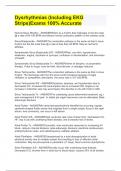
Dysrhythmias (Including EKG Strips)Exams 100% Accurate
Normal Sinus Rhythm - ANSWERRefers to a rhythm that originates in the SA node @ a rate of 60-100 BPM and follows normal conduction pattern of the cardiac cycle. Sinus Bradycardia - ANSWERThe conduction pathway is the same as that in sinus rhythm but the SA node fires @ a rate of less than 60 BPM. May be normal in athletes. Symptomatic Sinus Bradycadia S/S - ANSWERPale, cool skin, hypotension, weakness, angina, dizziness or syncope, confusion or disorientation, and shortness of breath. S...
- Exam (elaborations)
- • 2 pages •
Normal Sinus Rhythm - ANSWERRefers to a rhythm that originates in the SA node @ a rate of 60-100 BPM and follows normal conduction pattern of the cardiac cycle. Sinus Bradycardia - ANSWERThe conduction pathway is the same as that in sinus rhythm but the SA node fires @ a rate of less than 60 BPM. May be normal in athletes. Symptomatic Sinus Bradycadia S/S - ANSWERPale, cool skin, hypotension, weakness, angina, dizziness or syncope, confusion or disorientation, and shortness of breath. S...
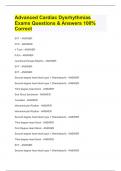
Advanced Cardiac Dysrhythmias Exams Questions & Answers 100% Correct
SVT - ANSWER PVC - ANSWER V Tach - ANSWER PJCs - ANSWER Junctional Escape Rhythm - ANSWER SVT - ANSWER SVT - ANSWER Second degree heart block type 1 (Wenkebach) - ANSWER Second degree heart block type 1 (Wenkebach) - ANSWER Third degree heart block - ANSWER Sick Sinus Syndrome - ANSWER Torsades - ANSWER Idioventricular Rhythm - ANSWER
- Exam (elaborations)
- • 3 pages •
SVT - ANSWER PVC - ANSWER V Tach - ANSWER PJCs - ANSWER Junctional Escape Rhythm - ANSWER SVT - ANSWER SVT - ANSWER Second degree heart block type 1 (Wenkebach) - ANSWER Second degree heart block type 1 (Wenkebach) - ANSWER Third degree heart block - ANSWER Sick Sinus Syndrome - ANSWER Torsades - ANSWER Idioventricular Rhythm - ANSWER
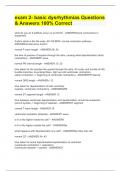
exam 2- basic dysrhythmias Questions & Answers 100% Correct
what do you do if artifacts occur on an ECG? - ANSWERcheck connections in equipment rhythm starts in the SA node, 60-100 BPM, normal conduction pathway - ANSWERnormal sinus rhythm normal P wave length - ANSWER.06-.20 the time of passive of impulse through the atria, causing atrial depolarization (atrial contraction) - ANSWERP wave normal PR interval length - ANSWER.12-.20 time taken for the impulse the spread through the atria, AV node, and bundle of HIS, bundle branches, & purkin...
- Exam (elaborations)
- • 5 pages •
what do you do if artifacts occur on an ECG? - ANSWERcheck connections in equipment rhythm starts in the SA node, 60-100 BPM, normal conduction pathway - ANSWERnormal sinus rhythm normal P wave length - ANSWER.06-.20 the time of passive of impulse through the atria, causing atrial depolarization (atrial contraction) - ANSWERP wave normal PR interval length - ANSWER.12-.20 time taken for the impulse the spread through the atria, AV node, and bundle of HIS, bundle branches, & purkin...
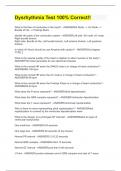
Dysrhythmia Test 100% Correct!!
What is the flow of conduction in the heart? - ANSWERSA Node --> AV Node --> Bundle of His --> Purkinje fibers Identify the parts of the conduction system - ANSWERLeft side: SA node, AV node, Right bundle branch Right side: Bundle of His, Left bundle branch, Left anterior division, Left posterior division In which AV block should we use Atropine with caution? - ANSWER2nd degree TYPE 2 What is the special quality of the heart in relation to other muscles in the body? - ANSWERTh...
- Exam (elaborations)
- • 6 pages •
What is the flow of conduction in the heart? - ANSWERSA Node --> AV Node --> Bundle of His --> Purkinje fibers Identify the parts of the conduction system - ANSWERLeft side: SA node, AV node, Right bundle branch Right side: Bundle of His, Left bundle branch, Left anterior division, Left posterior division In which AV block should we use Atropine with caution? - ANSWER2nd degree TYPE 2 What is the special quality of the heart in relation to other muscles in the body? - ANSWERTh...
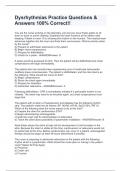
Dysrhythmias Practice Questions & Answers 100% Correct!!
You are the nurse working on the telemetry unit and you have finally gotten to sit down to work on some charting. Suddenly the heart monitors at the station start beeping. Patient in room 18 is showing this rhythm on the monitor. The medical team advances together into the room and finds them unconscious. What is priority action by the nurse? A) Prepare to administer adenosine to the patient B) Begin chest compressions C) Prepare for defibrillation D) Check for a pulse - ANSWERAnswer: D A...
- Exam (elaborations)
- • 14 pages •
You are the nurse working on the telemetry unit and you have finally gotten to sit down to work on some charting. Suddenly the heart monitors at the station start beeping. Patient in room 18 is showing this rhythm on the monitor. The medical team advances together into the room and finds them unconscious. What is priority action by the nurse? A) Prepare to administer adenosine to the patient B) Begin chest compressions C) Prepare for defibrillation D) Check for a pulse - ANSWERAnswer: D A...
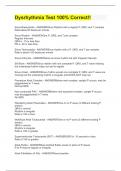
Dysrhythmia Test 100% Correct!!
Sinus Bradycarida - ANSWERSInus Rhythm with a regular P, QRS, and T complex Rate below 60 beats per minute Sinus Rhythm - ANSWEROne P, QRS, and T per complex Regular Intervals QRS is .10 or less than PR is .20 or less than Sinus Tachycardia - ANSWERSinus rhythm with a P, QRS, and T per complex Rate is above 100 beats per minute Sinus Arrhymia - ANSWERSame as sinus rhythm but with irregular intervals SA Block - ANSWERSinus rhythm with one complete P, QRS, and T wave missing ...
- Exam (elaborations)
- • 3 pages •
Sinus Bradycarida - ANSWERSInus Rhythm with a regular P, QRS, and T complex Rate below 60 beats per minute Sinus Rhythm - ANSWEROne P, QRS, and T per complex Regular Intervals QRS is .10 or less than PR is .20 or less than Sinus Tachycardia - ANSWERSinus rhythm with a P, QRS, and T per complex Rate is above 100 beats per minute Sinus Arrhymia - ANSWERSame as sinus rhythm but with irregular intervals SA Block - ANSWERSinus rhythm with one complete P, QRS, and T wave missing ...
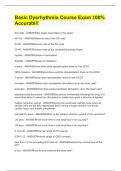
Basic Dysrhythmia Course Exam 100% Accurate!!
SA node - ANSWERthe major pacemaker of the heart 60-100 - ANSWERinherent rate of the SA node 40-60 - ANSWERinherent rate of the AV node 20-40 - ANSWERinherent rate of the ventricles (purkinjie fibers) systole - ANSWERphase of contraction diastole - ANSWERphase of relaxation p wave - ANSWERwhat does atrial depolarization show on the ECG? QRS complex - ANSWERwhat does ventricle depolarization show on the ECG? T wave - ANSWERwhat does repolarization show on the ECG? incre...
- Exam (elaborations)
- • 6 pages •
SA node - ANSWERthe major pacemaker of the heart 60-100 - ANSWERinherent rate of the SA node 40-60 - ANSWERinherent rate of the AV node 20-40 - ANSWERinherent rate of the ventricles (purkinjie fibers) systole - ANSWERphase of contraction diastole - ANSWERphase of relaxation p wave - ANSWERwhat does atrial depolarization show on the ECG? QRS complex - ANSWERwhat does ventricle depolarization show on the ECG? T wave - ANSWERwhat does repolarization show on the ECG? incre...
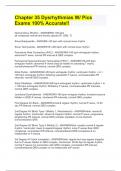
Chapter 35 Dysrhythmias W/ Pics Exams 100% Accurate!!
Normal Sinus Rhythm - ANSWER60-100 bpm all complexes normal and evenly spaced (P, QRS, T) Sinus Bradycardia - ANSWER< 60 bpm with normal sinus rhythm Sinus Tachycardia - ANSWER101-200 bpm with normal sinus rhythm Premature Atrial Contraction (PAC) - ANSWER60-100 bpm w/irregular rhythm; abnormal P wave, normal PR interval & QRS complex Paroxysmal Supraventricular Tachycardia (PSVT) - ANSWER150-220 bpm w/regular rhythm; abnormal P wave (may be hidden in preceding T wave), normal/sh...
- Exam (elaborations)
- • 2 pages •
Normal Sinus Rhythm - ANSWER60-100 bpm all complexes normal and evenly spaced (P, QRS, T) Sinus Bradycardia - ANSWER< 60 bpm with normal sinus rhythm Sinus Tachycardia - ANSWER101-200 bpm with normal sinus rhythm Premature Atrial Contraction (PAC) - ANSWER60-100 bpm w/irregular rhythm; abnormal P wave, normal PR interval & QRS complex Paroxysmal Supraventricular Tachycardia (PSVT) - ANSWER150-220 bpm w/regular rhythm; abnormal P wave (may be hidden in preceding T wave), normal/sh...
